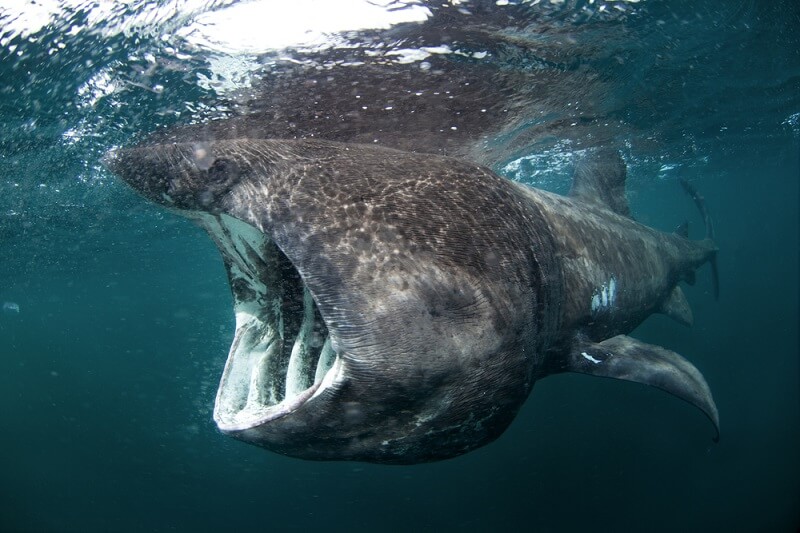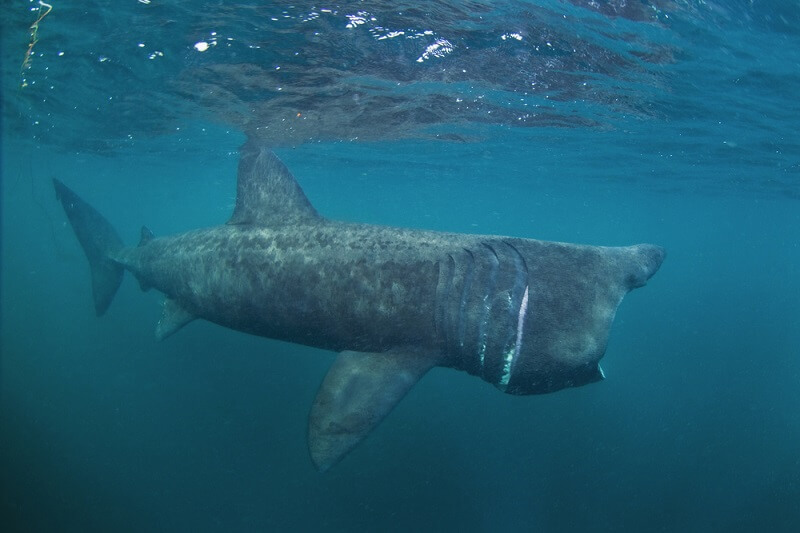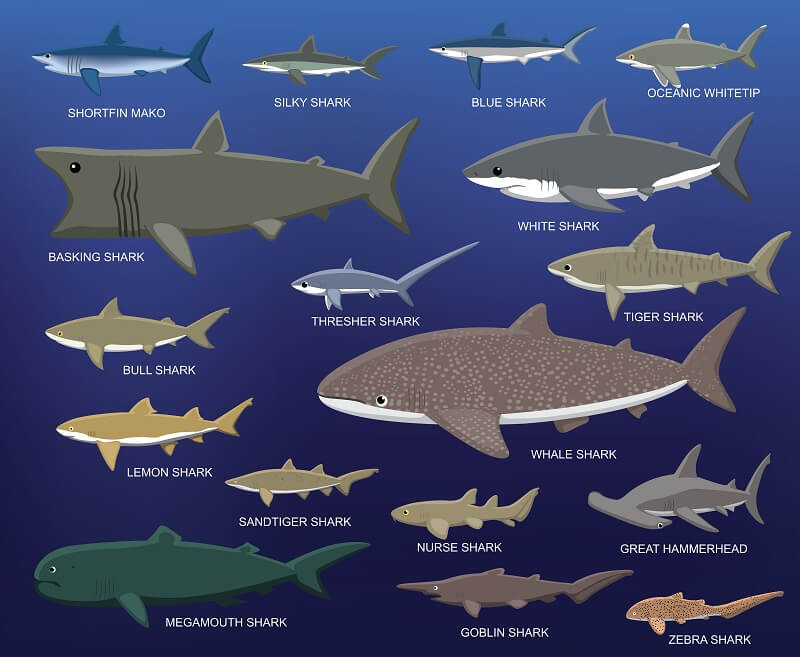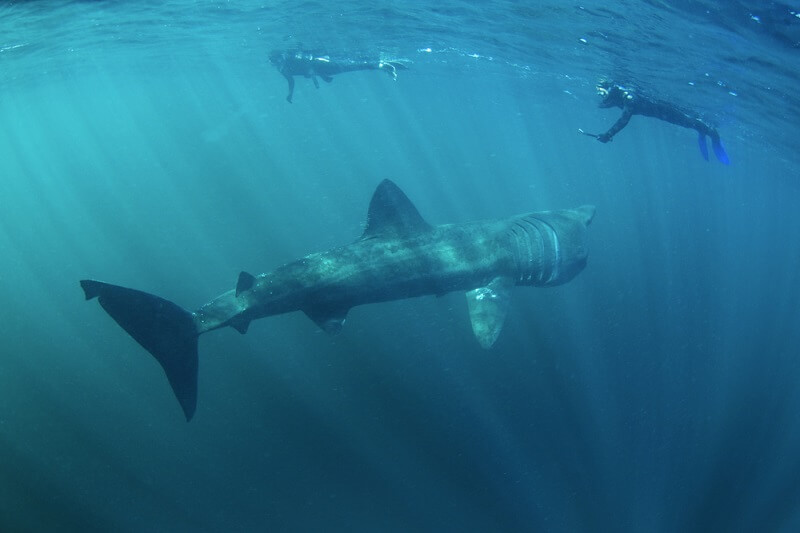
The Basking Shark is the second largest species of extant shark, only smaller than the Whale Shark in overall size. Compared to Great White Sharks, they are much larger. Like whale sharks, basking sharks are filter feeders that grow to enormous size while eating the ocean’s smallest organisms! Basking sharks can reach enormous sizes – some have been over 40 feet long and weigh as much as 16 tons! Due to their slow movement, docile nature, and lack of sharp teeth, basking sharks have long been a target of the fishing industry. However, its populations have dwindled considerably due to all the harvesting, and the shark is now considered Endangered. With a jaw that can be 3 feet wide, basking sharks may look intimidating. But, looks can be deceiving. Basking sharks are not known to be aggressive or dangerous, and will often circle groups of snorkelers and divers calmly. As a filter feeder, basking sharks have no desire to eat humans or other large animals. Instead, basking sharks spend nearly all of their time and energy following the plankton as it blooms and grows in different areas of the ocean. These sharks will follow groups of plankton from the surface of the ocean to over 3000 feet deep. Basking shark shoals will migrate thousands of miles every year chasing the best plankton blooms. Interestingly, basking sharks are ovoviviparous. This means the female does not lay eggs but instead allows the eggs to develop inside of her. Here, young sharks can grow to nearly 5 feet long before she gives birth to them – keeping them safe from even the largest predators! While the basking shark is interesting enough in its own rite – you might be surprised to find out that this species also displays some fascinating biological concepts that are seen in other species. Whale sharks, basking sharks, blue whales, and bowhead whales: what do they have in common? First, they are some of the largest animals on the planet. Whale sharks, basking sharks, and bowhead whales are truly mammoth species. The blue whale is the largest animal ever found – including the largest dinosaur fossils ever found. So, they’re all really big. Second, they are all planktivores! Believe it or not, all of these massive species feed only on microscopic algae and other tiny organisms. To do this, they must filter a massive amount of water every day. Most of these species swim along with their mouths open, allowing specialized filter organs to sift out the microscopic organisms so they can be swallowed. Scientists believe that while this strategy may take a lot of energy, there are also a lot of rewards. For instance, plankton is one of the most abundant organisms on the planet. This ensures these monstrous creatures never run out of food. Plus, organisms that grow to extreme sizes often have very few predators! In order to filter all that nutrient-rich plankton into their belly, plantivorous organisms need a special strategy. Whales use modified teeth called “baleen” to filter out tiny organisms in the water. Basking sharks use a strategy commonly employed by many fish. Instead of baleen, most fish that feed on plankton rely on structures that project out from their gills. Known as “gill rakers,” these projections are covered in tiny cilia that help capture and direct food to the throat while allowing water to pass. Gill rakers are continually shed and renewed, much like the teeth of an average shark species. With these specialized organs, filter-feeding sharks and fish can feed just by swimming with their mouth open! Interestingly, basking sharks have almost completely lost their teeth. What they do have are hundreds of tiny, curved teeth that are no longer useful for capturing food. Instead, it is thought that these teeth play a role in mating by allowing the shark pair to hold onto each other while internal fertilization is completed. While many sharks simply lay eggs and leave them to develop, the basking shark takes a strategy that requires a bit more of an investment: ovovivipary. The “ovo-” means eggs, while the “vivipary” means live birth. And, that’s exactly what happens. The eggs are fertilized internally and are retained within a uterus-like chamber. As they hatch, they rely on the nutrients in their egg sack in order to grow. Some researchers assume that the new young may eat unfertilized eggs as a food source. After as long as 2-3 years, the young are finally born. To us, they would look like a full-grown shark at 5 feet long. But, they have a long way to go to reach their nearly 40 feet potential. Being born at nearly 5 feet long ensures that basking sharks have very few natural predators – so they should have an easy time of it. Unfortunately, humans are the main predator of basking sharks and have harvested them close to extinction!
Kingdom
Animalia
Phylum
Chordata
Class
Chondrichthyes
Order
Lamniformes
Family
Cetorhinidae
Genus
Cetorhinus
Species
Cetorhinus maximus
Niche
Planktivore
Length
Up to 40 feet (12.25 m)
Weight
35,500 lbs (16 tonnes)
Lifespan
Unknown – estimated at 50+ years
Social Structure
Solitary or in Small Shoals
Conservation Status
Endangered
Preferred Habitat
Coastal to Pelagic globally
Average Litter Size
Around 6, needs more study
Main Prey Species
Zooplankton, Phytoplankton
Predators
Humans
The Basics

Interesting Insights from the Basking Shark!
Monstrous Planktivores!

Gill Rakers

Ovovivipary

